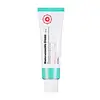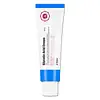What's inside
What's inside
 Key Ingredients
Key Ingredients

 Benefits
Benefits

 Concerns
Concerns

 Ingredients Side-by-side
Ingredients Side-by-side

Centella Asiatica Leaf Water
Skin ConditioningWater
Skin ConditioningCyclopentasiloxane
EmollientPropanediol
SolventPhenyl Trimethicone
Skin ConditioningGlycerin
HumectantPEG-10 Dimethicone
Skin ConditioningNiacinamide
SmoothingCyclohexasiloxane
EmollientPanthenol
Skin ConditioningEthoxydiglycol
HumectantDisteardimonium Hectorite
StabilisingSodium Chloride
MaskingRubus Suavissimus Leaf Extract
Skin ConditioningCentella Asiatica Extract
CleansingCaprylyl Glycol
EmollientPinus Densiflora Leaf Extract
AntimicrobialHamamelis Virginiana Leaf Extract
Skin ConditioningDimethicone Crosspolymer
Emulsion StabilisingCamellia Sinensis Leaf Extract
AntimicrobialButylene Glycol
HumectantMadecassoside
AntioxidantPentylene Glycol
Skin ConditioningCaprylhydroxamic Acid
Adenosine
Skin ConditioningLactic Acid
BufferingSodium Lactate
BufferingUrea
BufferingSerine
MaskingDisodium EDTA
Sorbitol
HumectantCitrus Grandis Peel Oil
MaskingAsiaticoside
AntioxidantCitrus Limon Peel Oil
MaskingPelargonium Graveolens Flower Oil
MaskingLavandula Hybrida Oil
EmollientJuniperus Mexicana Oil
MaskingCitrus Nobilis Peel Oil
MaskingAllantoin
Skin ConditioningChlorphenesin
AntimicrobialPhenoxyethanol
PreservativeCentella Asiatica Leaf Water, Water, Cyclopentasiloxane, Propanediol, Phenyl Trimethicone, Glycerin, PEG-10 Dimethicone, Niacinamide, Cyclohexasiloxane, Panthenol, Ethoxydiglycol, Disteardimonium Hectorite, Sodium Chloride, Rubus Suavissimus Leaf Extract, Centella Asiatica Extract, Caprylyl Glycol, Pinus Densiflora Leaf Extract, Hamamelis Virginiana Leaf Extract, Dimethicone Crosspolymer, Camellia Sinensis Leaf Extract, Butylene Glycol, Madecassoside, Pentylene Glycol, Caprylhydroxamic Acid, Adenosine, Lactic Acid, Sodium Lactate, Urea, Serine, Disodium EDTA, Sorbitol, Citrus Grandis Peel Oil, Asiaticoside, Citrus Limon Peel Oil, Pelargonium Graveolens Flower Oil, Lavandula Hybrida Oil, Juniperus Mexicana Oil, Citrus Nobilis Peel Oil, Allantoin, Chlorphenesin, Phenoxyethanol
Betula Alba Juice
AstringentWater
Skin ConditioningPropanediol
SolventTromethamine
BufferingGlycolic Acid
BufferingCetearyl Alcohol
EmollientGlycereth-26
Humectant1,2-Hexanediol
Skin ConditioningNiacinamide
SmoothingButylene Glycol
HumectantGlycerin
HumectantCyclopentasiloxane
EmollientBeeswax
Emulsion StabilisingDimethicone
EmollientPolysorbate 60
EmulsifyingCyclohexasiloxane
EmollientSorbitan Stearate
EmulsifyingPEG-240/Hdi Copolymer Bis-Decyltetradeceth-20 Ether
StabilisingGlyceryl Stearate
EmollientPanthenol
Skin ConditioningSalicylic Acid
MaskingArtemisia Princeps Leaf Extract
Skin ConditioningXanthan Gum
EmulsifyingHydroxyacetophenone
AntioxidantSodium Acrylate/Sodium Acryloyldimethyl Taurate Copolymer
Emulsion StabilisingPEG-100 Stearate
Isohexadecane
EmollientPEG-2m
Emulsion StabilisingHydrogenated Lecithin
EmulsifyingAllantoin
Skin ConditioningSucrose Distearate
EmollientPolysorbate 80
EmulsifyingAdenosine
Skin ConditioningSorbitan Oleate
EmulsifyingDisodium EDTA
Pantolactone
HumectantLactobacillus/Pumpkin Ferment Extract
Skin ConditioningPhenoxyethanol
PreservativeAnanas Sativus Fruit Extract
Skin ConditioningAlchemilla Vulgaris Extract
AstringentArnica Montana Flower Extract
MaskingActinidia Chinensis Fruit Extract
EmollientPyrus Malus Fruit Extract
Skin ConditioningGaultheria Procumbens Leaf Extract
PerfumingBetula Alba Juice, Water, Propanediol, Tromethamine, Glycolic Acid, Cetearyl Alcohol, Glycereth-26, 1,2-Hexanediol, Niacinamide, Butylene Glycol, Glycerin, Cyclopentasiloxane, Beeswax, Dimethicone, Polysorbate 60, Cyclohexasiloxane, Sorbitan Stearate, PEG-240/Hdi Copolymer Bis-Decyltetradeceth-20 Ether, Glyceryl Stearate, Panthenol, Salicylic Acid, Artemisia Princeps Leaf Extract, Xanthan Gum, Hydroxyacetophenone, Sodium Acrylate/Sodium Acryloyldimethyl Taurate Copolymer, PEG-100 Stearate, Isohexadecane, PEG-2m, Hydrogenated Lecithin, Allantoin, Sucrose Distearate, Polysorbate 80, Adenosine, Sorbitan Oleate, Disodium EDTA, Pantolactone, Lactobacillus/Pumpkin Ferment Extract, Phenoxyethanol, Ananas Sativus Fruit Extract, Alchemilla Vulgaris Extract, Arnica Montana Flower Extract, Actinidia Chinensis Fruit Extract, Pyrus Malus Fruit Extract, Gaultheria Procumbens Leaf Extract
Ingredients Explained
These ingredients are found in both products.
Ingredients higher up in an ingredient list are typically present in a larger amount.
Adenosine is in every living organism. It is one of four components in nucleic acids that helps store our DNA.
Adenosine has many benefits when used. These benefits include hydrating the skin, smoothing skin, and reducing wrinkles. Once applied, adenosine increases collagen production. It also helps with improving firmness and tissue repair.
Studies have found adenosine may also help with wound healing.
In skincare products, Adenosine is usually derived from yeast.
Learn more about AdenosineAllantoin is a soothing ingredient known for its protective and moisturizingg properties. Because of this, it is often added to products with strong active ingredients.
Studies show higher concentrations of this ingredient can promote wound healing.
Though it can be derived from the comfrey plant, allantoin is produced synthetically for cosmetic products to ensure purity.
Learn more about AllantoinButylene Glycol (or BG) is used within cosmetic products for a few different reasons:
Overall, Butylene Glycol is a safe and well-rounded ingredient that works well with other ingredients.
Though this ingredient works well with most skin types, some people with sensitive skin may experience a reaction such as allergic rashes, closed comedones, or itchiness.
Learn more about Butylene GlycolCyclohexasiloxane is a type of silicone more commonly known as D6. It is an emollient and solvent.
Cyclohexasiloxane is used to evenly distribute ingredients throughout the product. When applied to the skin, Cyclohexasiloxane evaporates and leaves behind a silky feel.
As an emollient, it can help the skin feel soft and hydrated. It is also used to reduce frizz in hair products.
Learn more about CyclohexasiloxaneCyclopentasiloxane, or D5, is a silicone used to improve texture of products and trap moisture.
D5 is considered lightweight and volatile. Volatile means it evaporates quickly after application. Once evaporated, D5 leaves a thin barrier that helps keep skin hydrated.
It is also an emollient. Emollients help soften the skin and prevent water loss. Silicones create a silky texture in products. D5 helps other ingredients become more spreadable.
Studies show D5 is safe to use in skincare products. We recommend speaking with a skincare professional if you have concerns.
Learn more about CyclopentasiloxaneDisodium EDTA plays a role in making products more stable by aiding other preservatives.
It is a chelating agent, meaning it neutralizes metal ions that may be found in a product.
Disodium EDTA is a salt of edetic acid and is found to be safe in cosmetic ingredients.
Learn more about Disodium EDTAGlycerin is already naturally found in your skin. It helps moisturize and protect your skin.
A study from 2016 found glycerin to be more effective as a humectant than AHAs and hyaluronic acid.
As a humectant, it helps the skin stay hydrated by pulling moisture to your skin. The low molecular weight of glycerin allows it to pull moisture into the deeper layers of your skin.
Hydrated skin improves your skin barrier; Your skin barrier helps protect against irritants and bacteria.
Glycerin has also been found to have antimicrobial and antiviral properties. Due to these properties, glycerin is often used in wound and burn treatments.
In cosmetics, glycerin is usually derived from plants such as soybean or palm. However, it can also be sourced from animals, such as tallow or animal fat.
This ingredient is organic, colorless, odorless, and non-toxic.
Glycerin is the name for this ingredient in American English. British English uses Glycerol/Glycerine.
Learn more about GlycerinNiacinamide is a multitasking form of vitamin B3 that strengthens the skin barrier, reduces pores and dark spots, regulates oil, and improves signs of aging.
And the best part? It's gentle and well-tolerated by most skin types, including sensitive and reactive skin.
You might have heard of "niacin flush", or the reddening of skin that causes itchiness. Niacinamide has not been found to cause this.
In very rare cases, some individuals may not be able to tolerate niacinamide at all or experience an allergic reaction to it.
If you are experiencing flaking, irritation, and dryness with this ingredient, be sure to double check all your products as this ingredient can be found in all categories of skincare.
When incorporating niacinamide into your routine, look out for concentration amounts. Typically, 5% niacinamide provides benefits such as fading dark spots. However, if you have sensitive skin, it is better to begin with a smaller concentration.
When you apply niacinamide to your skin, your body converts it into nicotinamide adenine dinucleotide (NAD). NAD is an essential coenzyme that is already found in your cells as "fuel" and powers countless biological processes.
In your skin, NAD helps repair cell damage, produce new healthy cells, support collagen production, strengthen the skin barrier, and fight environmental stressors (like UV and pollution).
Our natural NAD levels start to decline with age, leading to slower skin repair, visible aging, and a weaker skin barrier. By providing your skin niacinamide, you're recharging your skin's NAD levels. This leads to stronger, healthier, and younger looking skin.
Another name for vitamin B3 is nicotinamide. This vitamin is water-soluble and our bodies don't store it. We obtain Vitamin B3 from either food or skincare. Meat, fish, wheat, yeast, and leafy greens contain vitamin B3.
The type of niacinamide used in skincare is synthetically created.
Learn more about NiacinamidePanthenol is a common ingredient that helps hydrate and soothe the skin. It is found naturally in our skin and hair.
There are two forms of panthenol: D and L.
D-panthenol is also known as dexpanthenol. Most cosmetics use dexpanthenol or a mixture of D and L-panthenol.
Panthenol is famous due to its ability to go deeper into the skin's layers. Using this ingredient has numerous pros (and no cons):
Like hyaluronic acid, panthenol is a humectant. Humectants are able to bind and hold large amounts of water to keep skin hydrated.
This ingredient works well for wound healing. It works by increasing tissue in the wound and helps close open wounds.
Once oxidized, panthenol converts to pantothenic acid. Panthothenic acid is found in all living cells.
This ingredient is also referred to as pro-vitamin B5.
Learn more about PanthenolPhenoxyethanol is a preservative that has germicide, antimicrobial, and aromatic properties. Studies show that phenoxyethanol can prevent microbial growth. By itself, it has a scent that is similar to that of a rose.
It's often used in formulations along with Caprylyl Glycol to preserve the shelf life of products.
Propanediol is an all-star ingredient. It softens, hydrates, and smooths the skin.
It’s often used to:
Propanediol is not likely to cause sensitivity and considered safe to use. It is derived from corn or petroleum with a clear color and no scent.
Learn more about PropanediolWater. It's the most common cosmetic ingredient of all. You'll usually see it at the top of ingredient lists, meaning that it makes up the largest part of the product.
So why is it so popular? Water most often acts as a solvent - this means that it helps dissolve other ingredients into the formulation.
You'll also recognize water as that liquid we all need to stay alive. If you see this, drink a glass of water. Stay hydrated!
Learn more about Water